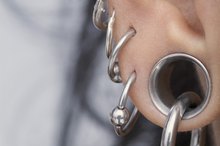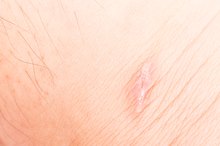What does fact checked mean?
At Healthfully, we strive to deliver objective content that is accurate and up-to-date. Our team periodically reviews articles in order to ensure content quality. The sources cited below consist of evidence from peer-reviewed journals, prominent medical organizations, academic associations, and government data.
The information contained on this site is for informational purposes only, and should not be used as a substitute for the advice of a professional health care provider. Please check with the appropriate physician regarding health questions and concerns. Although we strive to deliver accurate and up-to-date information, no guarantee to that effect is made.
The Risks of Wrist Tattoos
Wrist tattoos can go on the inside or outside of your wrist or circle your entire wrist like a bracelet. Properly caring for your tattoo immediately after getting it is essential to minimizing some of the risks of tattooing, such as skin infections. Applying antibiotic ointment to the new tattoo, keeping it covered for two weeks and not picking at the scar tissue will allow for proper healing
If you are experiencing serious medical symptoms, seek emergency treatment immediately.
General Risks
Getting a tattoo anywhere on your body, including on your wrist, comes with certain risks 1. Your skin might have an allergic reaction to the ink used in tattooing process. Tattooing also comes with a risk of introducing blood-borne diseases such as Hepatitis A, Hepatitis C or HIV to your blood. The best way to protect yourself from these risks is to make certain your tattoo artist uses only sterilized equipment, clean and new needles taken from sealed packaging and wears protective latex gloves.
- Getting a tattoo anywhere on your body, including on your wrist, comes with certain risks 1.
- The best way to protect yourself from these risks is to make certain your tattoo artist uses only sterilized equipment, clean and new needles taken from sealed packaging and wears protective latex gloves.
Specific Risks
Does it Hurt to Have Your Palm Tattooed?
Learn More
Your wrists have significantly less fatty tissue on them than other parts of your body. This means the professional giving you your tattoo will have to be careful of the veins both on your inner and outer wrist. You do not want the tattoo needles to penetrate too deeply into the skin where they can potentially cause damage to or inject ink into the veins. A skilled tattoo professional will have received training to prevent damage to the veins.
- Your wrists have significantly less fatty tissue on them than other parts of your body.
- This means the professional giving you your tattoo will have to be careful of the veins both on your inner and outer wrist.
Pain
Less fatty tissue around your wrist means you will likely experience more pain in getting a wrist tattoo than you would with getting a tattoo on another part of your body. Fatty tissue protects nerve endings and helps to minimize pain. On your wrist your nerves are closer to the skin's surface and therefore feel pain from the tattooing needles more intensely. Of course, pain tolerance is specific to you as an individual.
- Less fatty tissue around your wrist means you will likely experience more pain in getting a wrist tattoo than you would with getting a tattoo on another part of your body.
- On your wrist your nerves are closer to the skin's surface and therefore feel pain from the tattooing needles more intensely.
Visibility
How to Heal a Sprained Wrist Quickly
Learn More
Before getting your tattoo consider whether you are comfortable with its visibility to others. Wrist tattoos can be more difficult to hide or cover up than other tattoos 1. Even long shirt sleeves can pull up on the arm, exposing the tattoo to others. This can have implications particularly in professional settings or on job interviews where it is important your tattoo remain covered. The further away the tattoo is from your hand and palm the easier it will be to cover when necessary. Remember you will need to keep the tattoo bandaged for at least two weeks after getting it. The bandaging might also be visible to others.
- Before getting your tattoo consider whether you are comfortable with its visibility to others.
Related Articles
References
- Mayo Clinic: Tattoos: Understand Risks and Precautions
- Lynn C, Michaela, Herdrich D, et al. The evolutionary adaptation of body art: Tattoo as an honest signal of enhanced immune response in American Samoa. Amer J Hum Biol. 2019:e23347. doi:10.1002/ajhb.23347
- Wilson WT, O’Boyle M, Leach WJ. Unusual complication of a tattoo in an immunosuppressed patient. Case Reports 2018; 2018:bcr-2018-224968. doi:10.1136/bcr-2018-224968
- Oanţă A, Irimie M. Tinea on a tattoo. Acta Dermatovenerol Croat. 2016;24(3):223-4.
- Tohme RA, Holmberg SD. Transmission of hepatitis C virus infection through tattooing and piercing: a critical review. Clin Infect Dis. 2012;54:1167–1178. doi:10.1093/cid/cir991
- Centers for Disease Control and Prevention. HIV transmission. Updated August 6, 2019.
- Warshaw EM, Schlarbaum JP, Taylor JS, et al. Allergic reactions to tattoos: Retrospective analysis of North American Contact Dermatitis Group data, 2001-2016. J Am Acad Dermatol. 2019;2:e61-e62. doi:10.1016/j.jaad.2019.09.077
- Kirby W, Alston DB, Chen AH. The incidence of hypertrophic scarring and keloid formation following laser tattoo removal with a quality-switched Nd:YAG laser. J Clin Aesthet Dermatol. 2016;9(5):43–47.
- Islam PS, Chang C, Selmi C, et al. Medical complications of tattoos: A comprehensive review. Clin Rev Allergy Immunol. 2016;50(2):273-86. doi:10.1007/s12016-016-8532-0
- Valbuena MC, Franco VE, Sánchez L, Jiménez HD. Sarcoidal granulomatous reaction due to tattoos: report of two cases. An Bras Dermatol. 2017;92(5 Suppl 1):138–141. doi:10.1590/abd1806-4841.20175860
- Orzan OA, Popa LG, Vexler ES, Olaru I, Voiculescu VM, Bumbăcea RS. Tattoo-induced psoriasis. J Med Life. 2014;7 Spec No. 2(Spec Iss 2):65–68.
- Ross JR, Matava MJ. Tattoo-induced skin "burn" during magnetic resonance imaging in a professional football player: a case report. Sports Health. 2011;3(5):431–434. doi:10.1177/1941738111411698
- Kaur RR, Kirby W, Maibach H. Cutaneous allergic reactions to tattoo ink. J Cosmet Dermatol. 2009;8:295-300. doi:10.1111/j.1473-2165.2009.00469.x
- Brady BG, Gold H, Leger EA, Leger MC. Self-reported adverse tattoo reactions: a New York City Central Park study. Contact Dermatitis. 2015 Aug;73:91-99. doi:10.1111/cod.12425
- Forbat E, Al-Niaimi F. Patterns of reactions to red pigment tattoo and treatment methods. Dermatol Ther (Heidelb). 2016;6(1):13–23. doi:10.1007/s13555-016-0104-y
- Rosenbaum BE, Milam EC, Seo L, Leger MC. Skin care in the tattoo parlor: A survey of tattoo artists in New York City. Dermatology. 2016;232:484-489. doi:10.1159/000446345
- Khunger N, Molpariya A, Khunger A. Complications of tattoos and tattoo removal: Stop and think before you ink. J Cutan Aesthet Surg. 2015;8:30–36. doi:10.4103/0974-2077.155072
- United States Food and Drug Administration. Tattoos & permanent makeup; fact sheet. Oct 31, 2019.
Writer Bio
Erika Sanders has been writing since 1997. She teaches writing at the Washington State Reformatory and edits the monthly newsletter for the Collaborative on Health and the Environment, a national nonprofit organization. She received her Master of Fine Arts in fiction from the Solstice Program at Pine Manor College in Boston.









